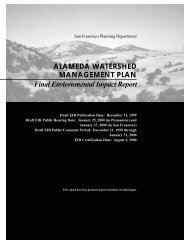Feasibility of Fish Passage at Alameda Creek Diversion Dam
Feasibility of Fish Passage at Alameda Creek Diversion Dam
Feasibility of Fish Passage at Alameda Creek Diversion Dam
Create successful ePaper yourself
Turn your PDF publications into a flip-book with our unique Google optimized e-Paper software.
5.0 Capital and Oper<strong>at</strong>ing and Maintenance Costs5.2.1 REDUCTION IN DIVERSION CAPACITY DUE TOSCREENINGThe capacity <strong>of</strong> the ACDT to transfer w<strong>at</strong>er to Calaveras Reservoir would likely be reduced if screeningwas implemented according to the criteria described by NMFS (1997 and 2008) and CDFG (2009). Ingeneral, fish screening criteria include a combin<strong>at</strong>ion <strong>of</strong> (1) low approach velocity, and (2) adequ<strong>at</strong>esweeping velocity. Approach velocity is defined as the velocity <strong>of</strong> w<strong>at</strong>er th<strong>at</strong> passes through a screeningdevice perpendicular to the screen openings. Sweeping velocity is the velocity <strong>of</strong> w<strong>at</strong>er th<strong>at</strong> runsparallel to the screen openings. At ACDD, the sweeping velocity requirement would be met byproviding a fish screen bypass <strong>at</strong> the downstream end <strong>of</strong> the screens. W<strong>at</strong>er costs associ<strong>at</strong>ed with thefish screen bypass are addressed in Section 5.2.2. The purpose <strong>of</strong> this section is to quantify reductionsin the amount <strong>of</strong> w<strong>at</strong>er th<strong>at</strong> could be diverted to Calaveras Reservoir due to potential reductions in themaximum r<strong>at</strong>e <strong>at</strong> which w<strong>at</strong>er could be diverted through the ACDT, if screening was implemented.The current maximum diversion r<strong>at</strong>e through the ACDT is estim<strong>at</strong>ed to be approxim<strong>at</strong>ely 650 cfs. Whenscreens are used, an approach velocity <strong>of</strong> 0.33 fps 9 is typically required by CDFG (2009) to protect fishfrom impingement. NMFS (1997 and 2008) also has approach velocity criteria, which vary dependingupon site specifics. At ACDD, NMFS criteria would be less restrictive than CDFG’s (2009), so theCDFG criterion is used for the purposes <strong>of</strong> analysis in this memorandum. Approach velocity anddiversion r<strong>at</strong>e are rel<strong>at</strong>ed to screen area; for a given r<strong>at</strong>e <strong>of</strong> diversion, a larger screen area will result in alower approach velocity. Altern<strong>at</strong>ively st<strong>at</strong>ed, for a given approach velocity, increasing the screen areaincreases the maximum potential diversion r<strong>at</strong>e, as shown on Figure 5-1. Therefore, a primary constraintduring screen design is the size <strong>of</strong> screen th<strong>at</strong> a site can accommod<strong>at</strong>e. Because <strong>of</strong> the site constraints and2500Screen Area in square feet20001500100050000 100 200 300 400 500 600 700 800Flow in CFSFigure 5-1Flow versus Required Screen Area9 The screen approach velocity <strong>at</strong> ACDD would be determined in coordin<strong>at</strong>ion with NMFS and CDFG.ACDD <strong>Passage</strong> June 2009 Page 5-3








